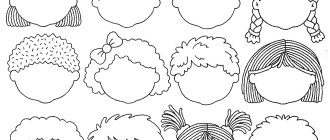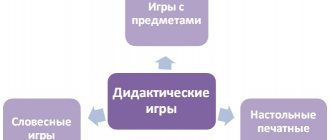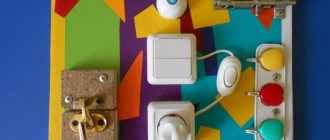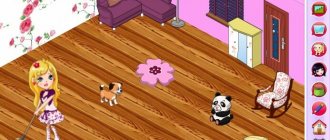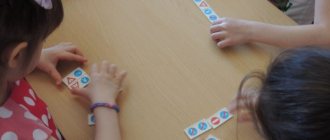Games without visual aids
Verbal games with the youngest kindergarten students come in two types: based only on speech and with partial use of visual material or objects. Among the games of the first type there are:
- games - “add-ons”;
- playing on literary works and folklore;
- finger games.
In all three versions of such games there is a general rule - they are played on the basis of a text that is well known to children . Kids need to complete simple tasks: add a word to a poem or riddle, show the actions voiced in the work with gestures, facial expressions, movements of fingers or palms. Since imitation is highly developed in children of primary preschool age, the adult who conducts the game must have correct, literate speech, be positively disposed and be able to express the necessary emotions. The children’s desire to continue to engage in this type of activity in the future depends on how teachers or parents present the game.
Verbal games in the family help to establish close emotional contact between parents and children
Table: examples of word games with children of the younger group based on texts
| Name and objectives of the game | Content |
| “ Add a word ” Teach children to carefully follow the flow of the story, listen to the sound of words, and add a word that suits the meaning. Develop attention, form the first idea of rhyme. Cultivate interest in artistic expression and folklore. | A simple poem is taken, understandable to children, with which they are already familiar (but have not learned it by heart). The teacher reads the line, pausing before the last word; the children must pronounce this word. Folklore (“Water, water”, “Ladushki”, “Pussy, shoot!”) is suitable for this game, as well as poems by A. Barto from the “Toys” cycle, Korney Chukovsky “Zakalyaka”, “Chicken”. |
| “ Guess the riddle ” Develop children’s logical thinking and speech, arouse interest in solving riddles, develop the ability to listen to the riddle to the end and only then name the answer. | An adult reads a riddle, the answer in which rhymes with the main text, the children say the answer. From the second half of the year, you can introduce riddles, the answer to which does not rhyme; you need to find it, focusing only on the content of the text. Rhyming riddles:
Riddles without rhymes:
|
| “ Let's show the doll a poem ” Teach children to pronounce individual phrases of a poetic text, accompanying them with appropriate actions. develop coherent speech, intonation expressiveness, attention. Cultivate a love of literature, folklore, and theatrical activities. | Educator: - Guys, the doll Olya came to visit us. She loves to listen to poetry, and you know a lot of interesting poems. Let's not only tell them to Olya, but also show them. The teacher recites a poem or nursery rhyme, showing the necessary gestures and movements, and the students repeat after him. For example:
The nursery rhymes “Goo-tu-tu”, “Magpie-crow”, “Ladushki”, poems “The Bear has a big house”, “The little gray bunny is sitting”, songs “I bake, I bake”, “The little gray cat” are suitable for playing. |
| Finger games Develop children's coherent speech, improve fine motor skills, coordination of speech and movements of fingers and palms. Cultivate organization, love of joint games, and perseverance. | These games are similar to playing, but all actions in them are depicted by movements of the fingers and palms.
|
Acting out poems is an activity adored by younger preschoolers.
Without visualization, in early preschool age, exercises are also carried out to develop speech breathing, the formation of correct sound pronunciation and articulation “Song of a mosquito, a bee, a train”, “Obedient tongue”, “Tell me like I am”. The teacher or parents clearly pronounce the sounds, point out the correct position of the lips and tongue, and the child repeats according to their example.
Word games for the younger group using visual aids
In addition to ordinary verbal games, when working with younger preschoolers, didactic games based on visualization (objects, subject and plot pictures) are used. Children of the fourth year of life must perceive a large amount of information, learn a lot of new words, master their various forms (diminutives, plurals), so help in the form of a visual aid will make the game more lively, brighter and a little more accessible to children’s understanding.
Looking at object pictures will help kids get an idea of the objects they will encounter in the game.
Word games serve not only to develop the speech of preschoolers. In them, children consolidate knowledge about the world around them, objects and living beings, natural phenomena, professions, family, and social phenomena. The themes of the games should be varied and cover the entire amount of knowledge provided for by the program, which students will have to learn during the school year. Accordingly, visual material for games will also be rich.
Table: examples of verbal didactic games based on visualization
| Name and objectives of the game | Content |
| “ Big - small ” To develop in children the ability to distinguish and name the size of objects, to develop logical thinking, coherent speech, attention, to cultivate concentration, perseverance, and cognitive activity. | For the game, they use a series of pictures that depict pairs of objects of different sizes (a large spruce and a small mushroom, a large house and a small booth, etc.), the teacher invites the child to look at the image and tell what is big and what is small. If the child finds it difficult, he is given an example: “The cat is big and the mouse is small.” Alternatively, the teacher can pronounce the first part of the sentence, and the child the second. |
| “ Which one, which one, which one?” » Activate the vocabulary of adjectives, learn to identify and correctly name the properties of objects, develop speech, thinking, curiosity, and memory. | Children are given pictures of objects, asked to look at them carefully and name what kind of object is depicted and what it is: “This is the sun, it’s yellow. This is a tomato. It's round and red." The teacher should encourage the child to describe those properties of objects that cannot be seen in the picture: “The sun is warm, the tomato is tasty, ripe, the tambourine is ringing, etc.” Description from memory is possible only if the group is systematically working to enrich the children’s vocabulary during classes, walks and other routine moments. |
| “ Moms and Cubs ” To consolidate children’s knowledge of the names of animals and their cubs, develop the ability to construct simple sentences, cultivate a love for animals, and a desire to take care of them. | Children are offered pictures (possibly in the form of puzzles) or figurines of animals and babies, and asked to find and bring each baby to their mother. When the pairs are made, the child and teacher describe them: “The cow has a calf, the dog has a puppy, the cat has a kitten.” |
| “ Find a Pair ” Develop children’s logical associative thinking, teach them to describe their choices in coherent phrases and sentences. Cultivate concentration and the ability to complete a task completely. | This game requires a set of pictures connected in logical pairs: a Christmas tree and a Christmas tree toy, a cat and a bowl of milk, a spool of thread and a needle. Preschoolers make pairs and tell in free form why they connected these particular pictures. Considering the age of the children, the teacher should not rely on their experience, but the first two or three times, independently create pairs of pictures and describe why they are similar. |
| “ Call the toy affectionately ” Consolidate knowledge of diminutive forms of nouns, learn to form them, develop grammatical hearing and attention. | The teacher puts a box of toys on the table in front of the children and says: “Today the toys came to play with us, but they are sad and hiding. They will play only when we call them affectionately. What is this? (Car). How to call her affectionately? (Machine). Yura, call the car kindly. Children, let’s call her together.” After this, the car is placed on the table in front of the children. They do the same with all the toys, after which the children play with them. You can offer to turn to toys with other affectionate words: “You are beautiful, you are cheerful, come to us, we will play with you.” |
| “ Say the opposite ” Intensify the use of antonym words in children’s speech, develop thinking, enrich vocabulary, cultivate emotional responsiveness and curiosity. | This game is difficult for younger preschoolers, because a small number of characteristics are based on visual perception, many properties and qualities the child needs to understand and comprehend at the emotional level, and he becomes acquainted with some through direct perception. Therefore, pictures depicting emotions (angry - kind, cheerful - sad), as well as objects made from various materials, are used as visual aids. By examining them, comparing and naming their properties, children also remember words with the opposite meaning: “The cube is wooden, it is hard. The duck is rubber and soft. The ball is smooth, but the bear is fluffy.” |
| “ Who hid where? » Intensify the use of prepositions in speech, consolidate the names of furniture, develop coherent speech, and the ability to express one’s thoughts. | To play you need a set of doll furniture (table, chair, wardrobe) and small toys. The teacher places the toys in random order, tells who hid where, and then asks them to repeat: “The tumbler is on the table, the bunny hid under the chair, the bear climbed into the closet, etc.” |
| " Who's doing what? » Teach children to correctly use verbs in a sentence, develop grammatical hearing, attention, and coherent speech. | This game is complete without action pictures. The children look at them, and then, with the help of the teacher, describe what the people or animals depicted in the pictures are doing: “The girl is watering the flowers. Grandma is knitting a scarf. Children swim in the river. The cat drinks milk. The rabbit is eating grass." |
| " Yes or no? » Develop logical thinking, the ability to identify and correctly name the characteristics of an object, and cultivate a love of logic games. | The teacher shows the children a toy fox and tells them that she wants to play with them, but they need to be very careful, because the fox loves to deceive and be cunning. Then he shows pictures or objects, describing them on behalf of the fox with mistakes: “What is this? (This Apple). Is the apple green? (No, it's red). Who is this? (This is a bunny). Does the bunny have a long tail? (No, short)." |
The child receives ideas about similar and opposite properties of objects in the process of direct examination of them.
Photo gallery: stimulus material for games in the younger group
It is better to select contrasting items for size comparison, so that it is easier for the child to navigate
Object pictures for the game “Which one?” have pronounced features and a small number of additional details that can distract babies
The game "Moms and Babies" also comes in the form of puzzles
You can make the “Match a Pair” game yourself or buy it in specialized stores.
To describe actions, junior group pilots are offered drawings rather than photographs.
Outdoor games with choral pronunciation of words, such as “Geese-geese”, “Inflate, bubble”, “Loaf” also bring great benefits to children . Since they are spent outdoors, children can not only practice pronouncing words correctly, but also pronounce them quickly and slowly, loudly and quietly, which teaches them to control the strength of their voice and the pace of speech. The teacher needs to make sure that the kids do not scream too loudly, because this is harmful to the speech apparatus.
Folk outdoor games are of great value: in them, children get acquainted with wonderful examples of folklore, learn the beauty of their native speech
Verbal games are an excellent way to familiarize children not only with their native speech, but also with the world around them, the phenomena of society and nature. However, their use in the younger group requires the teacher and parents to have a good knowledge of child physiology and psychology. It is necessary to select such material for games so that children do not become overtired, but receive comprehensive development, information accessible to their age, and the joy of communicating with adults and peers.
Card file “Didactic games for speech development” younger age
Didactic games for speech development for young children.
1.
“Wonderful bag”
Purpose:
focus on the gender of the noun when defining an object by its characteristics.
Materials:
hare, carrot, cucumber, apple, tomato, bag.
Content.
“A hare came to our kindergarten. Running bunny, what's in your bag? Can I have a look? What is this? (Carrot.) What carrot? (Long, red.) Put the carrots on the table. And what's that? (Cucumber.) What cucumber? (In the same way we take out a tomato, apple, etc.)
Now the hare wants to play with you. He hid all the vegetables and fruits in a bag. The bunny will put his paw into the bag, take a vegetable or fruit and tell you about it, and you must guess what the bunny has in his paw. Listen carefully. It is long and red. What is this? (Carrot.) It is green and long. What is this? (Cucumber.) It is round and red. What is this? (Apple.) It is round and red. What is this? (Tomato.)"
If the children answer the last two questions incorrectly, we repeat, emphasizing the pronoun in our voice: “Listen again. It is round and red. It's round and red.
Now find and put vegetables in the bag. What's left? (Apple.) Apples are fruits. Thank you, hare, for coming to us. Goodbye".
2.
“Multi-colored bag”
Purpose:
focus on the ending when agreeing words in gender.
Materials
: chest, object pictures: egg, cookies, jam, apple, towel and other objects designated by neuter and feminine nouns, according to the number of children.
Content.
Let's put a chest with pictures on the table. We will invite the children to take out the pictures one at a time, while asking questions: “Which egg? What matryoshka?” Etc. The interrogative pronoun agrees with the noun and helps the child correctly determine the gender of the latter.
If the pictures show 2-3 objects, the game will take on a new meaning: the child will be able to practice forming the nominative plural forms of nouns.
3.
“Such a leaf - fly to me!”
Target.
Practice finding leaves by similarity, activate children's vocabulary (names of trees: maple, oak, rowan, birch), cultivate auditory attention.
Content.
The teacher, together with the children, collects tree leaves during a walk (according to the number of children, one for each). The children stand in a semicircle.
— Do you know what trees grow on our site? Let's name them and approach them. Look at the leaves of the maple - large with teeth. The leaves of the rowan tree are small, the leaf itself looks like a feather (By comparing and naming the leaves, the teacher finds out what children know about trees, how their leaves differ).
— I have leaves from different trees in my hands (shows). Let's repeat their names. I'll give you all a piece of paper and keep a few for myself. When I show a leaf and say: “Whoever has the same leaf, fly to me!” - you will run to me.
4.
“Who will collect it sooner?”
Target.
Correctly assemble the pyramid, first selecting large rings, then smaller and smaller ones; practice naming the size of the ring (large, smaller, even smaller, smallest).
Materials:
pyramids (according to the number of children), flags.
Content.
Play with a small group of children. Having distributed the pyramids to each child, the teacher attracts the attention of the children:
- Look at the ring below: big or small? (big)
- What is this? (smaller)
What ring is on top? (the smallest)
If children cannot answer on their own, the teacher helps:
- Remember that the largest ring is at the bottom, and what is at the top? (the smallest)
Now listen to how we will play with the pyramids. Let's first disassemble the pyramid (removes the rings, puts them on the table) and you do the same. And then, when I hit the ring on the table, you will quickly begin to assemble the pyramid. You need to assemble it correctly. Whoever collects the fastest will win. He will get a flag.
5.
“What has changed?”
Target.
Practice correctly naming objects and their actions (the nesting doll hid, came running, stands still), notice and name the difference in the color of clothing and the size of the nesting dolls.
Materials:
five different-sized multi-colored nesting dolls.
Content.
The teacher shows five nesting dolls one by one and, together with the children, names the colors of the clothes, noting that all the nesting dolls are different in size.
- What do you see on my table? (matryoshka dolls)
- Look at the height of the nesting dolls (places two, then three, and then four nesting dolls next to each other). Are they the same height or not? (different). What's different about them?
The teacher helps with guiding questions:
- Look at the handkerchiefs. What are they? (touches first one, then another nesting doll). One nesting doll has a red scarf, another has a green one, and this one has a blue one. How can we say about handkerchiefs in one word? (the handkerchiefs of the nesting dolls are of different colors).
— What about sundresses, how can you say? (sundresses are also different colors).
“Now let’s play like this: I’ll cover the matryoshka dolls with a screen, and then you’ll find out which doll will hide.” But you need to answer only one at a time, so the one who notices will come up to me and say quietly so that others do not hear.
Next, the teacher draws the children’s attention to the size of the nesting dolls: he hides behind the screen first one, then another, then two at once.
When the game is played again, the one the matryoshka points to answers.
6.
“Teremok”
Goal:
focus on the ending of the verb in the past tense when agreeing it with a noun.
Materials:
wooden tower, toy animals: mouse, frog, bunny, fox, wolf, bear.
Content .
Let's put a tower on the carpet. We will place the animals near the tower. We will tell a fairy tale, encouraging children to take part in the telling.
— There is a tower in the field. She ran to the tower... who? That's right, mouse. (Children give hints based on the meaning of the verb and its ending.) “Who lives in the little house?” Nobody here. The mouse began to live in the little house.
A frog galloped up to the tower. Etc. In conclusion, let's summarize:
- Listen to how we say: the frog jumped up,
and the bunny galloped up
the fox
came running,
and the wolf
came running.
7.
“What’s missing?”
Target:
practice forming genitive plural forms of nouns.
Materials:
pairs of objects: nesting dolls, pyramids (large and small), ribbons (of different colors and different sizes - long and short), horses, ducklings, Pinocchio, a bag.
Content.
Pinocchio appears in front of the children with a bag. He says that he brought toys for the guys. Children look at toys. They call them. They put it on the table.
- What is this? Matryoshka. Let's see what's inside the nesting doll. Another matryoshka. Place them next to each other. Vova, now take out the toy. What is this? (Pyramid.) Is there another pyramid? Etc.
- Remember what items are on the table. There are pyramids, nesting dolls, and ducklings. Pinocchio will play with you. He will hide toys, and you will have to say which toys are gone: nesting dolls, pyramids, ducklings or something else.
Three pairs of objects remain on the table: nesting dolls, pyramids, horses. Children close their eyes. We hide the nesting dolls and put ribbons in their place. (“Who’s missing?”) Then we hide the ribbons and put pyramids in their place. (“What’s missing?”) Etc. Finally, we remove all the toys and ask: “Which toys are missing?”
8.
“Where are our pens?”
Target:
practice forming genitive plural forms of nouns.
Content.
Children sit on chairs.
- Where are our pens? Our pens are gone! (We hide our hands behind our backs, the children do the same.) Here are our hands! (We show our hands and play with our fingers.)
- Where are our legs? Our legs are gone! (Children hide their legs under the chair.) Here are our legs! (They stomp their feet.)
- Where are our pens? What's missing? (Pens.) Here are our pens! - Where are our legs? What's missing? (Nozhek.) Here are ours
legs! The game is repeated 2-3 times.
9.
“Find an object by description”
Goal.
To develop the ability to find an object by its most characteristic features, to develop the ability to describe an object without naming it.
Materials:
Pinocchio toy.
Content.
The teacher, together with Pinocchio and the children, examine the objects that have been selected for the game (ball, truck, dog, doll, etc.). In this case, it is necessary to draw children’s attention to the appearance of objects, their shape, color, what they are made of, and what they are needed for. Then he invites the children to turn away (hides objects in different places).
- All our toys have fled, now you will look for them. First, I’ll tell you about the toy that you should find very first,” Buratino suggests. This is a round, rubber object that bounces and rolls along the floor (this is a ball).
- Seryozha, find the ball.
Pinocchio describes another toy:
— Plastic, green with a handle, they carry water in it to water the plants. What is this item? (bucket)
- Lena, look for a bucket and bring it here.
The game continues until the children find all the hidden objects according to the description.
10.
“Loto”
Purpose:
practice forming plural forms of nouns (in the nominative and genitive cases).
Materials:
pictures depicting objects in the singular and plural (matryoshka - nesting dolls, bucket - buckets, wheel - wheels, ring - rings, etc.).
Content.
We distribute pictures to the children, keeping the paired ones. We explain the conditions of the game:
- This is a game of attention. I will show pictures. Each picture shows a toy. Anyone who has a picture with the same toys should quickly say so. For example, I have a wheel. And Vera has wheels. Faith must quickly say, “I have wheels,” or “I have many wheels.” Toys must be named.
The one who hesitates gives his picture to an adult. If the child quickly and correctly names the toy, we give our picture to him.
At the end of the game, the losers (who do not have pictures on their hands) are offered comic tasks: jump on one leg, jump high, sit down three times, etc. We come up with tasks together with the children.
11.
“Choose dishes for the doll”
Goal:
consolidate knowledge about different types of dishes; develop the ability to use utensils for their intended purpose.
Materials.
Three dolls: one is a cook, the other is a nanny, the third is just a girl. Toy stove, toy dinnerware, toy table and chair.
Content.
The game is played after a conversation about the work of the cook and nanny, what utensils are used in their work. During the game, a cook doll stands near the stove, another nanny doll prepares dishes for dinner, and a girl doll sits at the table. The teacher asks to look at the dolls, there is a conversation about who they are, what they do, what utensils they need.
There are different dishes on the table near the teacher. Showing an object, he tells what this object is called (saucepan), the cook needs it.
- Kolya, take the pan to the cook and put it on the stove.
Next, the teacher shows the bread box:
- What is this item called, who needs it? (breadbox, it needs to be taken to the nanny).
The teacher shows a teaspoon:
- What is it, what is it for? (a teaspoon to put sugar in tea, eat cake).
One by one, the teacher shows all the dishes. To maintain interest, you can use the following options:
— And probably no one needs these dishes? (shows a ladle, colander or teapot),
- Needed, needed!
-Who needs a ladle? (to the cook)
- Does the nanny need it? (needed)
- So how many ladles are needed? (two). Let's look for another ladle (the children find another ladle and take it to the cook and nanny).
12.
“More is less”
Goal:
practice distinguishing and comparing the sizes of objects (more, less, the same)
Materials.
Natural material: cones, acorns, leaves, pebbles, shells (different in size, so that there is the same number of each type).
Content.
Children sit at the table and look at objects together with the teacher and name them.
- Let's look at the cones. Do you think they are the same in size or different? (Different) Vitya, show me which one is larger. Lena, so what kind of bump is this? (smaller)
“We’ll play with these cones, pebbles, leaves and shells today.” We will arrange them by size: first we will put the largest object, and then smaller and smaller ones (shows actions on the table with acorns).
- You need to put only identical objects in a row. The one who took the cones puts only the cones in a row. And who will take the leaf, the one that will put it in a row? (leaves)
At the teacher’s command, children lay out objects in a row on the table. Children select objects and arrange them by size (5-6 objects of each type).
- The one who quickly and correctly puts all the objects in a row wins.
13.
“Fold the picture”
Goal:
practice composing a whole object from its parts.
Materials.
The box contains whole pictures depicting different objects: vegetables, fruits, toys, plants. In another box there are the same pictures, cut into four equal parts.
Content.
The teacher introduces the pictures, the children name what is depicted on them. Then shows parts of the picture:
- What picture is this piece from? (from an apple). The teacher superimposes part of the picture onto the whole.
- Now let's find other parts of the apple.
Children look for pictures of apple parts when all the pieces are found and placed next to the whole picture:
— It turned out to be a whole apple. Now, I will give you pictures. I’ll give Sveta a pear, Vika a tomato, and Dima a carrot. Collect whole pictures from their parts (cut pictures are on the table).
Then the rules change:
“I won’t give you the whole picture, but a piece.” Using this piece, you can guess which picture needs to be assembled (if the child has guessed which object he will get, then he must be allowed to put together the whole picture to check the accuracy of the guess).
14.
“Hide and Seek”
Purpose:
correctly use prepositions with spatial meaning in speech
(in, on, about, under, before).
Materials:
truck, bear, mouse.
Content.
A bear and a mouse come to visit the children, and they begin to play hide and seek. The bear leads, and the mouse hides.
- Let's close our eyes. The mouse hid.
The bear is looking: “Where is the mouse? He’s probably under the car?” Where is he, guys? (In the cockpit.) Look where he got into!
Close your eyes again, the mouse will hide again. (We put the mouse on the cabin.) Where is the mouse? Guys, tell the bear!
In the same way, children look for a mouse, which is hiding under
by the car,
near
the car,
in front of
the car.
15.
“Lost”
Purpose:
match the name of the animal with the name of the baby.
Materials:
toy house, animals (toys): duck and duckling, hen and chicken, goat and kid, cow and calf, horse and foal.
Content.
Let's place adult animals around the room. Their cubs are on the carpet in the house.
- Let's get a look. Quack-quack-quack
- who is this? Duck? We take out the toy from the house. Is the duck big or small? Small? This, guys, is a duckling. Little duckling. And the duck is his mother. Help the duckling find his mother duck. Vasya, take the duckling. Look for the duck.
- Whose voice is this - pi-pi-pi?
Who is this? (We take out the chicken.) Who is the chicken's mother? How does a chicken cackle? How does the chicken respond? Look, Olya, for the chicken, the chicken’s mother.
The rest of the characters are played out in a similar way. When all the babies have mothers, the adults and cubs are placed together. Let the children look at them and say the words: duck
-
duckling, hen
-
chicken
, etc.
16.
“Houses”
Purpose:
use the names of baby animals.
Materials:
a tray with toys: squirrels, hares, ducklings, mice, etc. - according to the number of children, building material.
Content.
We bring a tray of toys into the room. We say that children should build houses for the kids. Everyone must first decide for whom he will build a house, and correctly ask an adult: “Please give me a duckling (little squirrel).”
If necessary, you need to suggest the whole word or just the beginning and ask the child to repeat the name.
We lay out building material on the carpet. Children build houses for their animals and play.
17.
“Who needs what for work?”
Target:
to consolidate children’s knowledge that different things and tools help people in their work.
Materials:
large cards depicting a cook, doctor, driver, builder, etc., and small cards depicting items necessary for work.
Content.
This game is played after conversations and observations of the work of people of different professions, paying attention to the tools of their work. As children become familiar with the work of adults, they add pictures depicting a builder, postman, salesman, milkmaid and the tools of their labor. The game is played according to the “Loto” type. There is a competition to see who can cover all the squares on large cards the fastest. The teacher clarifies the children’s knowledge about professions and the tools of their work, then reminds them of the rules of the lotto game. It is necessary to help with questions:
- What else does a doctor need? How does it measure temperature? What does he bandage with?
18.
Rattles"
Purpose:
follow the adult's word.
Materials:
rattles on the handle (2 for each child); boxes (baskets) for folding rattles.
Content.
Children stand in front of an adult who holds a box of rattles and says:
Everybody run to me quickly, you'll get some rattles!
(The adult quickly distributes rattles to the children)
The children took the rattles. They walked fast with them!
(The adult walks in front of the children, waving rattles)
They began to run and jump. Play with rattles!
(Children run around jingling rattles)
Now everyone needs to stand in a circle and show the rattles!
(Children stand in a circle)
Raise the rattles. And then lower them. Raise and lower! Raise and lower!
(Children raise and lower rattles)
The children began to squat and bang their rattles. Knock and straight! Knock and straight! Knock, knock, knock! And everyone stood up.
(Children squat, knock rattles on the floor, stand up, repeat these movements twice; in response to the words “knock, knock, knock,” they quickly knock rattles on the floor three times, then get up)
And now we're all running. We make rattles.
(Children run after an adult, waving rattles)
Quietly, quietly, let's all go. Let's remove the rattles!
(Children pass by a box placed on their way and put their rattles there)
19.
“Olin’s assistants”
Goal:
form the plural form of verbs.
Materials:
Olya doll.
Content.
- Children, the doll Olya and her assistants came to us. I’ll show them to you, and guess who these helpers are and what they help our Ole do.” The doll walks along the table. We point to her legs: “What are these? These are the legs. They are Olya's assistants. What do the legs do? (They walk, jump, run, skip, dance, etc.) Next, we point to other parts of the body and ask similar questions (hands - take, put, hold, wash, dress, draw, cut out, paste; teeth - chew, bite, gnaw; eyes - look, close, open, blink, squint; ears - listen).
Next, we read the poem, pausing, and the children suggest the right word:
Olya runs cheerfully along the path to the river, and for this Our Olya needs... legs.
Olya takes two or three berries. And for this, Our Olya needs... pens.
Olya gnaws on the kernels, the shells fall off, and for this our Olya needs... teeth.
Olya looks at the cat. To pictures-fairy tales. And for this, Our Olya needs... eyes.
20.
“Whose voice?”
Target:
form verbs from onomatopoeic words.
Materials.
Toys: cat, dog, chicken, cockerel, car.
Content.
Toys arrive by car. The adult shows them (one at a time), and the children name them.
- Cuckoo! Who is this? (Cockerel.) How does a cockerel crow? (Crow.)
- Where, where, where, where! Who is this? (Chicken.) How does the chicken cackle?
- Woof woof woof! Who is this? (Dog.) How does the dog bark?
- Meow meow! Who is this? (Cat.) How does a cat meow?
- Woof woof woof! Whose voice is this? (Dogs.) What is she doing? (Barks.)
- Meow meow! Whose voice is this? (Cats.) What is the cat doing? (Meows.)
- Where, where, where, where! Whose voice is this? (Chickens.) What does the chicken do? (Cackles.)
- Cuckoo! Who is this? (Cockerel.) What does the cockerel do? (Crows.)

